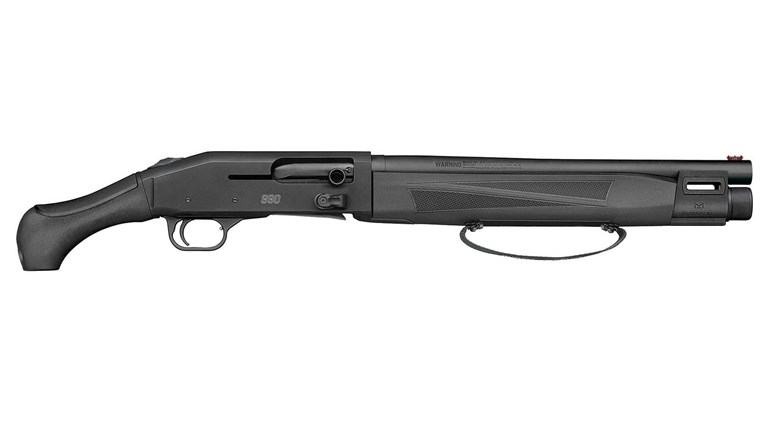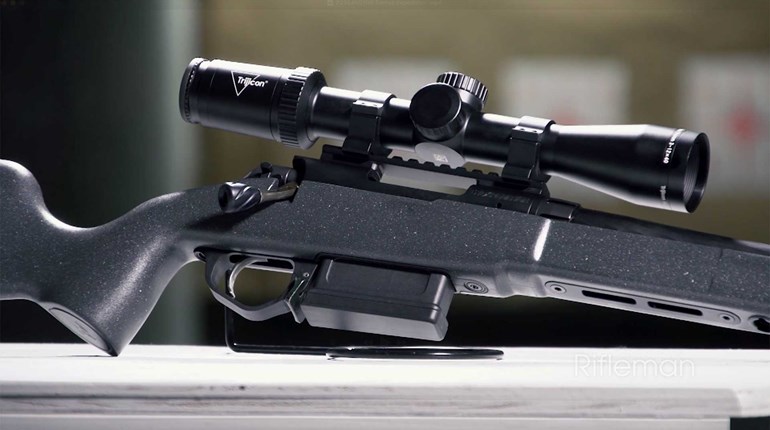
To decide whether too many gumshoe novels or grainy, black-and-white films are responsible is a hair-splitting affair, but the phrase, “Move along, there’s nothing to see here,” springs unbidden into our considerations of Mossberg’s MVP Precision rifle. The type, from Mossberg or otherwise, can hardly be considered new after all—chassis bolt guns have been arriving in relative torrents for several years now. Accurate, easy to configure and generally soft shooting for delivered power—especially in 6.5 mm Creedmoor—they are rightly popular and widely enjoyed. Is any real excitement justified for another (and arguably late-ish) arrival?
You’ll decide, naturally, but we presume to answer on behalf of Mossberg with a self-deprecating, “Yes.” As America’s oldest family-owned firearms manufacturer, a Mossberg (currently A. Iver Mossberg Jr.) has been at the helm for each of the company’s 99 years. That continuity, and a conspicuously sharp pencil, have resulted in notably sound designs and corollary success. Among them is the quietly fabulous 5xx series of pump-action shotguns that has sold more than 10 million unassuming copies, while a “more gun for the money” attitude has put durable quality and astonishing reliability in the hands of at least five generations of Americans.
It’s safe to say—though again, perhaps we presume—that the MVP Precision is no hasty attempt to catch the chassis trend, but a crafty plot to another understated coup.
In simple terms, chassis rifles dispense with a stock of the conventional sort. Precision-machined aluminum components replace wood, fiberglass, or some 20-something-inch-long, single piece of material as the “bed” for a bolt-type action. The upsides can be considerable: Free-floating of the barrel, box-magazine feeding and a really handy, clever stock implementation—in the action-to-shoulder sense—mark the Mossberg iteration.
These put a highly adjustable LUTH-AR MBA-3 stock at the “you” end, an M-lok accessory-compatible handguard at the other, and a well-planned heart to the rifle in between. There, a Magpul modern sporting rifle grip, appropriate magazine well and Mossberg’s Lightning Bolt Action adjustable trigger fill out the bottom; and a smooth-running bolt and deftly sculpted bolt handle, safety and mag release fill out the top. We’d grant that the configuration is a trifle odd looking on first inspection, but don’t judge too soon: Come shooting time, we found it uncommonly superb—comfortable, intuitive and correspondingly safe.
That same “shooting time” brought some unexpected complexities. A host of factory munitions performed modestly until break-in was completed. (“Nuts And Bolts” has what we’d suggest are crucial details, mainly at the courtesy of long-range genius and many-time national champion rifleman David Tubb.) In the end, performance from the MVP was very promising, as well as steadily improving: 10-shot groups of hand-loaded ammunition stayed under MOA, and as small as .833 inch. Shorter shot sequences were similarly encouraging, with three-shot groups regularly between .151 and ~.220, and five-shot strings—including factory Sig Sauer “Elite” 140-grain—under .45 inch. The soft recoil and flat trajectory of the 6.5 mm lived up to their reputation.
None of this should have been the slightest surprise. Mossberg’s longtime public face is “Legends of the Outdoors” Hall of Famer Linda Powell, one of the smartest, nicest people in our industry. She warned us in unusually certain terms—even for her—that eye and handling appeal were just the beginning for Mossberg’s classy chassis 6.5 mm. She also made it clear that she was cheerfully prepared to pry the rifle out of our hands after a civil interval.
Knowing what we know now, we’re determined to test her idea of “civil” and keep on shooting—and hitting—with the fine MVP Precision.
Frank Winn has been studying arms and their relationship to tyranny, meaningful liberty and personal security all his adult life. He has been a firearms safety/shooting instructor for more than 20 years, earned state, regional and national titles, and holds Master or Grand Master rank in several competitive disciplines.
Nuts And Bolts
Ammunition – Getting the MVP Precision to settle into hoped-for accuracy took longer than expected. That’s not really a problem if you think it through, and we did get an unusually good feel for the 3.25-pound LBA trigger by the time it mattered. The interim was just a tad hard on our ammunition stock. Thanks to Vista Outdoor—in the form of Federal ammunition (to generate fire-formed cases), Speer projectiles and Alliant powder—we were able to put Redding Reloading’s T-7 press and competition dies to work in bridging the gap.
We learned a couple of interesting things. First, our MVP’s 24-inch, 1:8-twist barrel showed a preference for heavier bullets. Factory “best” was the 140-grain SIG loading already noted, but it was edged by hand-loads in an essential tie between a 140-grain Speer “Gold Dot” and Hornady’s 143-grain “ELD-X” (actually a hunting projectile, but still producing our best 10-shot group).

We also learned that the Mossberg did better with a longer jump from case mouth to rifling (often called “freebore”) than we normally see. David Tubb straightened us out here: Bullets usually perform better right up against the rifling, but not always. Secant versus tangent ogive design in the bullet is a big factor, but just one of many. He also reminded us that “leade” and throat break-in are as individual as barrels: Most are showing their accuracy potential by 80 to 100 rounds, but it can take 200 to 300 in another rifle that will eventually perform just as well.
Optics – Burris put some great technology at our disposal with its Eliminator III 4-16x50 range finding scope. We used it straight-up most of the time, and performance in this role was just as we’ve come to expect—flawless, once mounted and sighted in. Our go-to range finding unit is a pair of Nikon 10x42 Laserforce binoculars, but after checking them against each other, the Nikons stayed home.
Using the built-in Burris software to calculate holdovers and wind dopes was impressive. For holdovers, the Eliminator takes into account your bullet’s ballistic coefficient and drop number (inches of drop at 750 yards when sighted in at 100) to create a ballistic profile for your ammunition. Matching to a ballistic table is done in the scope’s electronics. Ranging a target then calculates the correct holdover and lights your aim point on the vertical stadia. Windage depends on outside measurement or estimation, but the in-scope display makes recommendations based on 10 mph, and non-illuminated indicators make left or right adjustments in hold easy to coordinate with the illuminated distance correction in the X96, horus-style reticle. It’s a bit daunting the first time through (and there’s a dedicated website and good manual to boot), but that’s it—in the field, it's fast, reliable and accurate. A good press, and hits are away. It will feel like cheating when you get the hang of it.


































